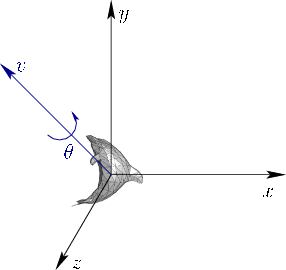
Next: Two-to-one problem Up: 3.3 Axis-Angle Representations of Previous: 3.3 Axis-Angle Representations of Contents Index
An even worse problem arises when using yaw, pitch, roll angles (and related Euler-angle variants). Even though they start off being intuitively pleasing, the representation becomes degenerate, leading to kinematic singularities that are nearly impossible to visualize. An example will be presented shortly. To prepare for this, recall how we represent locations on the Earth. These are points in
![]() , but are represented with longitude and latitude coordinates. Just like the limits of yaw and pitch, longitude ranges from 0 to
, but are represented with longitude and latitude coordinates. Just like the limits of yaw and pitch, longitude ranges from 0 to ![]() and latitude only ranges from
and latitude only ranges from ![]() to
to ![]() . (Longitude is usually expressed as 0 to
. (Longitude is usually expressed as 0 to ![]() degrees west or east, which is equivalent.) As we travel anywhere on the Earth, the latitude and longitude coordinates behave very much like
degrees west or east, which is equivalent.) As we travel anywhere on the Earth, the latitude and longitude coordinates behave very much like ![]() coordinates; however, we tend to stay away from the poles. Near the North Pole, the latitude behaves normally, but the longitude could vary a large amount while corresponding to a tiny distance traveled. Recall how a wall map of the world looks near the poles: Greenland is enormous and Antarctica wraps across the entire bottom (assuming it uses a projection that keeps longitude lines straight). The poles themselves are the kinematic singularities: At these special points, you can vary longitude, but the location on the Earth is not changing. One of two DOFs seems to be lost.
coordinates; however, we tend to stay away from the poles. Near the North Pole, the latitude behaves normally, but the longitude could vary a large amount while corresponding to a tiny distance traveled. Recall how a wall map of the world looks near the poles: Greenland is enormous and Antarctica wraps across the entire bottom (assuming it uses a projection that keeps longitude lines straight). The poles themselves are the kinematic singularities: At these special points, you can vary longitude, but the location on the Earth is not changing. One of two DOFs seems to be lost.
The same problem occurs with 3D rotations, but it is harder to visualize due to the extra dimension. If the pitch angle is held at
![]() , then a kind of ``North Pole'' is reached in which
, then a kind of ``North Pole'' is reached in which ![]() and
and ![]() vary independently but cause only one DOF (in the case of latitude and longitude, it was one parameter varying but causing zero DOFs). Here is how it looks when combining the yaw, pitch, and roll matrices:
vary independently but cause only one DOF (in the case of latitude and longitude, it was one parameter varying but causing zero DOFs). Here is how it looks when combining the yaw, pitch, and roll matrices:
The problems can be easily solved with axis-angle representations of rotation. They are harder to learn than yaw, pitch, and roll; however, it is a worthwhile investment because it avoids these problems. Furthermore, many well-written software libraries and game engines work directly with these representations. Thus, to use them effectively, you should understand what they are doing.
 |
The most important insight to solving the kinematic singularity problems is Euler's rotation theorem (1775), shown in Figure 3.9. Even though the rotation axis may change after rotations are combined, Euler showed that any 3D rotation can be expressed as a rotation ![]() about some axis that pokes through the origin. This matches the three DOFs for rotation: It takes two parameters to specify the direction of an axis and one parameter for
about some axis that pokes through the origin. This matches the three DOFs for rotation: It takes two parameters to specify the direction of an axis and one parameter for ![]() . The only trouble is that conversions back and forth between rotation matrices and the axis-angle representation are somewhat inconvenient. This motivates the introduction of a mathematical object that is close to the axis-angle representation, closely mimics the algebra of 3D rotations, and can even be applied directly to rotate models. The perfect representation: Quaternions.
. The only trouble is that conversions back and forth between rotation matrices and the axis-angle representation are somewhat inconvenient. This motivates the introduction of a mathematical object that is close to the axis-angle representation, closely mimics the algebra of 3D rotations, and can even be applied directly to rotate models. The perfect representation: Quaternions.
Steven M LaValle 2020-01-06